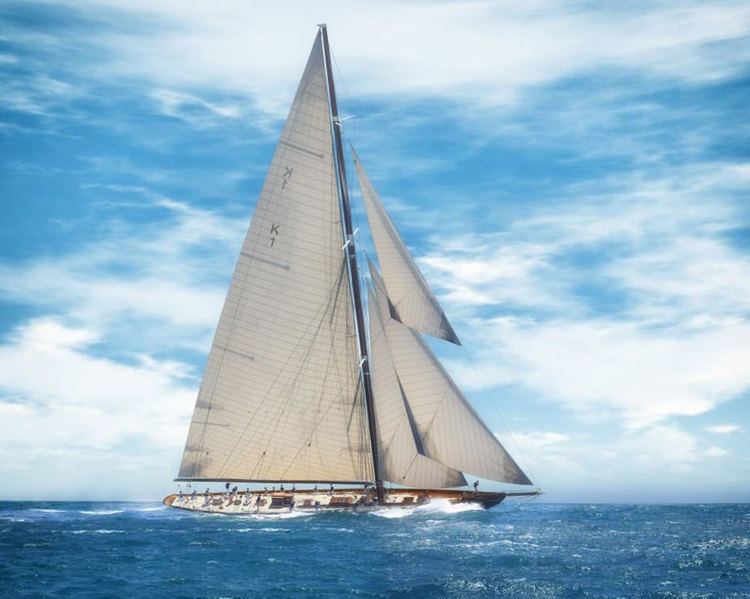Name Britannia Yard number 366 Length 37 m Displacement 200,500 kg Beam 7.21 m | Ordered 1892 Launched 20 April 1893 Weight 224.5 tons Draft 4.6 m | |
 | ||
Builder D&W Henderson Shipyard Ltd Fate scuttled (July 10th, 1936) | ||
His Majesty's Yacht Britannia was a gaff-rigged cutter built in 1893 for Commodore Albert Edward, Prince of Wales, who later became King Edward VII. She served him and his son King George V with a long racing career.
Contents
Racing career
After the Prince of Wales' nephew Kaiser Wilhelm II acquired the racing cutter Thistle in 1891, her Scottish designer George Lennox Watson received a commission from Prince Albert Edward for a sailing yacht in 1892. He designed His Royal Highness' Yacht Britannia to the "Length And Sail Area Rule" as a First Class cutter and had her built alongside his America's Cup challenger Valkyrie II at the D&W Henderson shipyard on the River Clyde. She was launched on April 20, 1893, a week ahead of Valkyrie II.
By the end of her first year's racing, Britannia had scored thirty-three wins from forty-three starts. In her second season, she won all seven races for the first class yachts on the French Riviera, and then beat the 1893 America's Cup defender Vigilant in home waters. In the Mount's Bay Regatta of July 28, 1894 the Vigilant owned by Mr. Jay Gould, Director of the American Cable Company was piloted by Benjamin Nicholls of Penzance and the Prince of Wales's (later Edward VII) yacht Britannia was piloted by Ben's brother Philip Nicholls. The Britannia won by just over 7 minutes. People came by train from all over the south west to watch this race. Both brothers were Trinity House pilots of Penzance.
Despite a lull in big yacht racing after 1897, Britannia served as a trial horse for Sir Thomas Lipton's first America's Cup challenger Shamrock, and later passed on to several owners in a cruising trim with raised bulwarks. In 1920, King George V triggered the revival of the "Big Class" by announcing that he would refit Britannia for racing. Although Britannia was the oldest yacht in the circuit, regular updates to her rig kept her a most successful racer throughout the 1920s. In 1931, she was converted to the J-Class with a bermuda rig, but despite the modifications, her performance to windward declined dramatically. Her last race was at Cowes in 1935. During her racing career she had won 231 races and took another 129 flags.
King George V's dying wish was for his beloved yacht to follow him to the grave. On 10 July 1936, after Britannia had been stripped of her spars and fittings, her hull was towed out to St Catherines Deep near the Isle of Wight, and she was sunk by HMS Winchester, commanded by Captain W.N.T. Beckett RN. This fate marked the end of big yacht racing in Europe, with the smaller and more affordable International Rule 12-Metre Class gaining popularity.
Three known examples of Britannia's racing flags are preserved, one presented by Sir Philip Hunloke to the Royal Cornwall Yacht Club, in whose Regattas Britannia was often a competitor between 1894 and 1935, at the Royal Northern and Clyde Yacht Club at Rhu and at the Royal St. George Yacht Club, which held two regattas in Kingstown for the first season of the RYA linear rating rule in 1896. Britannia's skipper William G. Jameson had lost both races to the new Meteor II and the Ailsa. Britannia's 51' long gaff, the king’s chair, tiller, some mast hoops, blocks and rigging, anchor chain and clock are preserved in the Sir Max Aitken Museum in Cowes High Street and the remains of her spinnaker boom are at Carrisbroke Castle, also on the Isle of Wight. The spinnaker boom was given for use as a flag pole on the keep (where it twice suffered lightning damage), and the present flagpole is a fibreglass replica.
Replica
K1 Britannia is a project to create a replica of the original vessel where K1 designates the Britannia's sail number when she was converted to the J class in 1931. In 1993 a syndicate headed by Norwegian Sigurd Coates purchased a stake in a shipyard in Arkhangelsk in order to create a replica of the Britannia in pinewood. Between 2002 and 2006 the shipyard changed hands several times whilst joinery was nearing completion. In 2006 she was rechristened Царь Пётр (Tsar Pyotr; "Peter the Great") and held back for NOK25,000,000 until 2009, when a Russian court ordered the hull to be launched and delivered by the shipyard to her original owner Sigurd Coates. Subsequently the hull was sailed to Son and berthed there until she was purchased by her present owners, a purposely-created British charity, and towed to East Cowes in 2012. Having also reached charity status in the United States of America in 2015, the project subsequently announced that it would raise funds there to finance the building of a new aluminium hull at a shipyard in Florida. The project has since fallen to a standstill.
Predecessors and Opponents
Previously Prince Albert Edward had acquired the 205-ton schooner Hildegarde in 1876, which he had replaced with the 103-ton cutter Formosa (Michael E. Ratsey, 1878) in 1879, and the 216-ton schooner Aline (Benjamin Nicholson, 1860) in 1881. From 1962 to 1969, the British Royal family also owned the ocean racing yawl Bloodhound (Charles E. Nicholson, 1936).
Britannia faced many opponents in her 43-year career. The most notable were:
